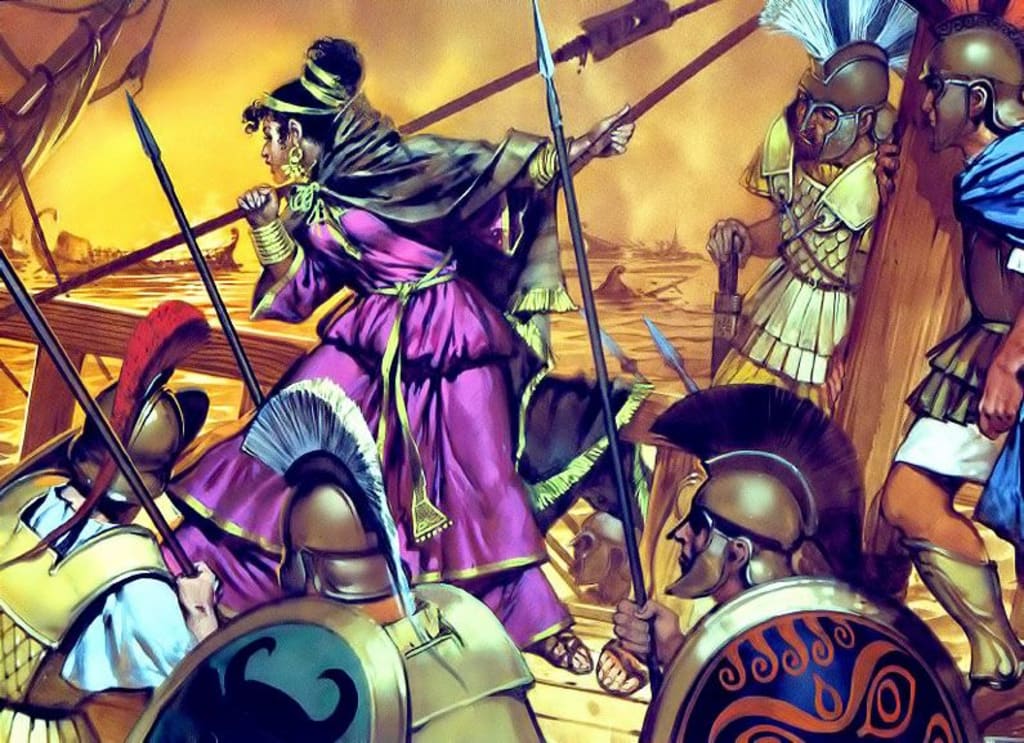Queen Artemisia
A fascinating figure from ancient history

Artemisia is one of the central characters in the 2014 film “300: Rise of an Empire”. However, the events portrayed on the silver screen are probably a long way from the truth about this ancient warrior queen.
Queen Artemisia in fiction
The 2014 film “300: Rise of an Empire” was based on the comic books of Frank Miller, as was the earlier “300”, released in 2006, which was a fictionalised retelling of the Battle of Thermopylae, which took place during the Persian invasion of Greece in 480 BC. Given Frank Miller’s reputation for turning sketchy historical narratives into blockbuster movie material, it is no surprise that drama takes precedence over accuracy in his work.
Another factor to bear in mind is that Miller’s comic book “Xerxes” had not been released before “300: Rise of an Empire” was made. This therefore gave extra scope for interpretation of the characters and events.
According to the film, Artemisia (played by Eva Green) had risen from poverty to become the chief admiral in command of the Persian fleet led by King Xerxes. She was supposedly an orphan from an overrun Greek province who had been raised by the Persians to become a ruthless fighter under first Darius and then Xerxes.
She is central to the action at the naval battles of Artemisium and Salamis (August and September 480 BC), between which she manages to have a brief but passionate liaison with the Greek commander Themistocles.
Having despatched a large number of Greek soldiers, she finally meets her end during a one-to-one encounter with Themistocles.
Her story therefore ticks a lot of Hollywood boxes – victory against the odds, a redoubtable woman fighter, lots of violent combat, a bit of passionate sex and nudity for good measure, and a death at the end that seals everything up.
But how near the truth is the fiction?
The knowledge we have of the real Artemisia comes almost entirely from the “Histories” of Herodotus, a Greek who lived and wrote in the 5th century BC. He was born in around 484 BC and would therefore have been a very young child at the time of Battle of Salamis and the events that preceded and followed it. His facts could however have been based on interviews with older people who had been around at the time.
Another factor that inclines one to believe what he says about Artemisia is that he was a native of the Greek colony of Halicarnassus, as was she. There is every reason to believe that he could have spoken to people who had personal knowledge of Artemisia.
Against this claim to accuracy one must also take into account the fact that Herodotus was renowned for accepting stories and myths as real happenings. Also, he was known to have used other written sources, nearly all of which have been lost, and he sometimes gave warnings that his sources could not always be trusted.
In other words, one cannot rely on the whole of the Histories for accuracy. However, when it comes to the reliability of records of events within the lifetime of his interviewees, and concerning his own city, it is now generally thought that he was probably not far wrong.
Queen Artemisia
Given the above caveats, the real Artemisia ruled over the kingdoms of Caria and Ionia, in what is now the coastal region of south-west Turkey. She became queen on the death of her husband, whose name is unknown.
She allied herself with the Persians when King Xerxes launched his invasion of Greece, and contributed five ships to the Persian war fleet, which probably amounted to around 1200 ships in total. Her contingent was therefore a very small element of the total force.
On the eve of the Battle of Salamis, Xerxes held a council of war with all his generals and admirals, of whom Artemisia was only one among many. She was outvoted on the question of whether to attack the much smaller Greek fleet in the narrow Bay of Salamis, as she could see the danger inherent in so doing. Herodotus quoted her as pleading with Xerxes: “Spare your ships and do not fight at sea, for the Greeks are infinitely superior to us in naval matters”.
Although her advice was ignored, she joined the battle with her five ships.

Queen Artemisia at the Battle of Salamis
According to Herodotus, Artemisia found herself in a desperate situation when her contingent of warships became surrounded by Greek triremes. Her way out was to use her ship to ram another Persian ship, which then sank.
King Xerxes, who was watching the battle from a clifftop overlooking the bay, assumed that she had sunk a Greek ship. The Greeks, being closer to the action, assumed that she had changed sides by sinking a Persian ship. Both the Persians and the Greeks therefore gave her a clear passage to make her escape.
The Battle of Salamis turned out to be a devastating defeat for Xerxes, whose ambition to conquer Greece went no further.
The later life of Queen Artemisia
Artemisia was therefore free to return to her kingdom, although she disappears from history at this stage. There is absolutely no evidence that she died at the hand of Themistocles during the Battle of Salamis. The only firm fact known about her after Salamis is that when she died she was succeeded by her grandson.

There was a legend – almost certainly false – that she used her ability to switch sides to her advantage by become a pirate and flying whichever flag suited her convenience at the time – Persian if hunting down a Greek ship and Greek if trying to escape from one.
One cannot be surprised if Frank Miller sought to embroider history by adding a few legends and stories to what probably happened. After all, his mentor Herodotus was a past master at doing precisely that!
About the Creator
John Welford
I am a retired librarian, having spent most of my career in academic and industrial libraries.
I write on a number of subjects and also write stories as a member of the "Hinckley Scribblers".






Comments
There are no comments for this story
Be the first to respond and start the conversation.